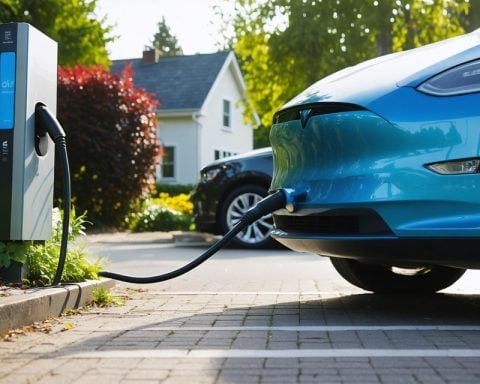- NASCAR has introduced 30 new electric vehicle chargers at its Daytona Beach headquarters, signaling a push towards sustainability.
- This initiative is part of NASCAR’s commitment to reduce its carbon footprint to zero by 2035, under the NASCAR IMPACT program.
- The new Level 2 chargers are available for employees and industry insiders, representing a shift from fossil fuels to electric power.
- Key partners in this sustainable drive include Florida Power & Light (FPL) and ABB, who support NASCAR’s transition from traditional fuel to electricity.
- Future plans involve exploring sustainable racing fuels and electric race vehicles, moving towards a more environmentally friendly motorsport.
NASCAR roars forward, not just in speed, but in sustainability. Nestled amid the buzz of Daytona Beach, the iconic organization has unveiled a fleet of 30 new electric vehicle chargers, marking a strategic partnership that hints at a greener, more sustainable tomorrow.
At the heart of NASCAR’s headquarters, these sleek, futuristic Level 2 chargers await employees and industry insiders eager to plug into the future. It’s a vivid step in the ambitious vision of NASCAR IMPACT—an audacious pledge to slash its carbon footprint to zero by 2035. The silent hum of electricity powering up at the headquarters marks the dawn of a new era, one where the thrill of the race harmonizes with the call for sustainability.
The transformation of NASCAR’s operations from fuel-dependent (scope 1) towards electric (scope 2) gains momentum with the support of partners like Florida Power & Light (FPL) and ABB. This electrification initiative is not just about adding charging stations; it’s part of a grander strategy to revolutionize all corners of the sport, stretching from fleet vehicles to the racetrack itself.
Imagining a day when sustainable racing fuels and energy-efficient technologies dominate the scene isn’t a distant dream. ABB’s involvement hints at strategic opportunities, contemplating electric race vehicles and beyond. As partnerships deepen, NASCAR charges ahead, embracing innovations that promise to keep motorsports exhilarating while being environmentally mindful.
In this high-octane sport, the balance of speed and sustainability doesn’t seem so far off. Amid the roar of engines, it’s the quiet surge of electricity that might just redefine the race for years to come.
The Electrifying Future of NASCAR: Speed Meets Sustainability
How-To Steps & Life Hacks: Charging Ahead with Sustainability
1. Understand the Basics: Transitioning to green technology can seem daunting, but diving into the basics of electric vehicles (EVs) and their infrastructure is essential. Learn about different types of chargers (Level 1, 2, 3) and consider installing a Level 2 charger for moderate to high usage.
2. Harness Strategic Partnerships: Just as NASCAR collaborates with Florida Power & Light (FPL) and ABB, businesses should look for partners to help them achieve sustainability goals. Identify stakeholders with aligned interests to foster meaningful change.
3. Assess & Implement: Organizations should conduct a thorough assessment of their current energy use and potential areas for improvement. Implementing small steps towards electrification can lead to significant impacts over time.
4. Engage and Educate: Encourage employees and industry members to adopt sustainable practices. Initiatives like in-house seminars and incentives for using electric transport can foster a culture of sustainability.
Real-World Use Cases and Benefits
– Corporate Headquarters: Installing EV chargers like at NASCAR’s headquarters can significantly reduce the carbon footprint of daily operations. It also demonstrates corporate responsibility and attracts environmentally conscious employees.
– Community Influence: As influential figures in motorsports, NASCAR’s sustainability initiatives can inspire local communities and fans to consider greener transportation options.
– Event Venues: Transitioning to electric power can modernize sports venues, reducing energy costs and setting a standard for environmental responsibility in large-scale public events.
Market Forecasts & Industry Trends
The electric vehicle (EV) market is projected to grow significantly, with progression in battery technology and government incentives worldwide promoting adoption. By 2030, it is estimated that EVs could constitute over 30% of global vehicle sales. As the industry evolves, innovative partnerships like NASCAR’s will be instrumental in driving this transformation.
Pros & Cons Overview
– Pros:
– Environmental Impact: Reduced carbon emissions and environmental footprint.
– Economic Benefits: Decreases in fuel costs and potential tax incentives.
– Brand Image: Enhances corporate reputation as a sustainability leader.
– Cons:
– Initial Investment: High upfront costs for infrastructure development.
– Compatibility Issues: Existing vehicles and infrastructure may need retrofitting.
– Range Anxiety: Limited for race distances due to current EV battery technology.
Controversies & Limitations
While NASCAR’s move towards electrification is commendable, challenges remain regarding the complete viability of electric racing. Industry purists may resist changes that alter traditional racing dynamics. Furthermore, the current limitations in EV battery life and charging times could impact race logistics and fan experiences.
Actionable Recommendations
1. Stay Informed: Follow industry trends to align sustainability initiatives with the latest technology.
2. Start Small: Implement pilot programs that can scale up based on initial results and feedback.
3. Foster a Community: Engage stakeholders across different levels, from fans to partners, to create a robust support system for sustainability efforts.
For more insights into sustainability and electric vehicles, visit NASCAR, ABB, and Florida Power & Light.
Conclusion
As NASCAR accelerates towards a sustainable future, it paves the way for other industries to follow. With a synergistic approach combining speed and sustainability, motorsports are set to redefine entertainment and environmental responsibility for the better. Let the quiet hum of innovation spark ideas for your organization to race into a greener future.












